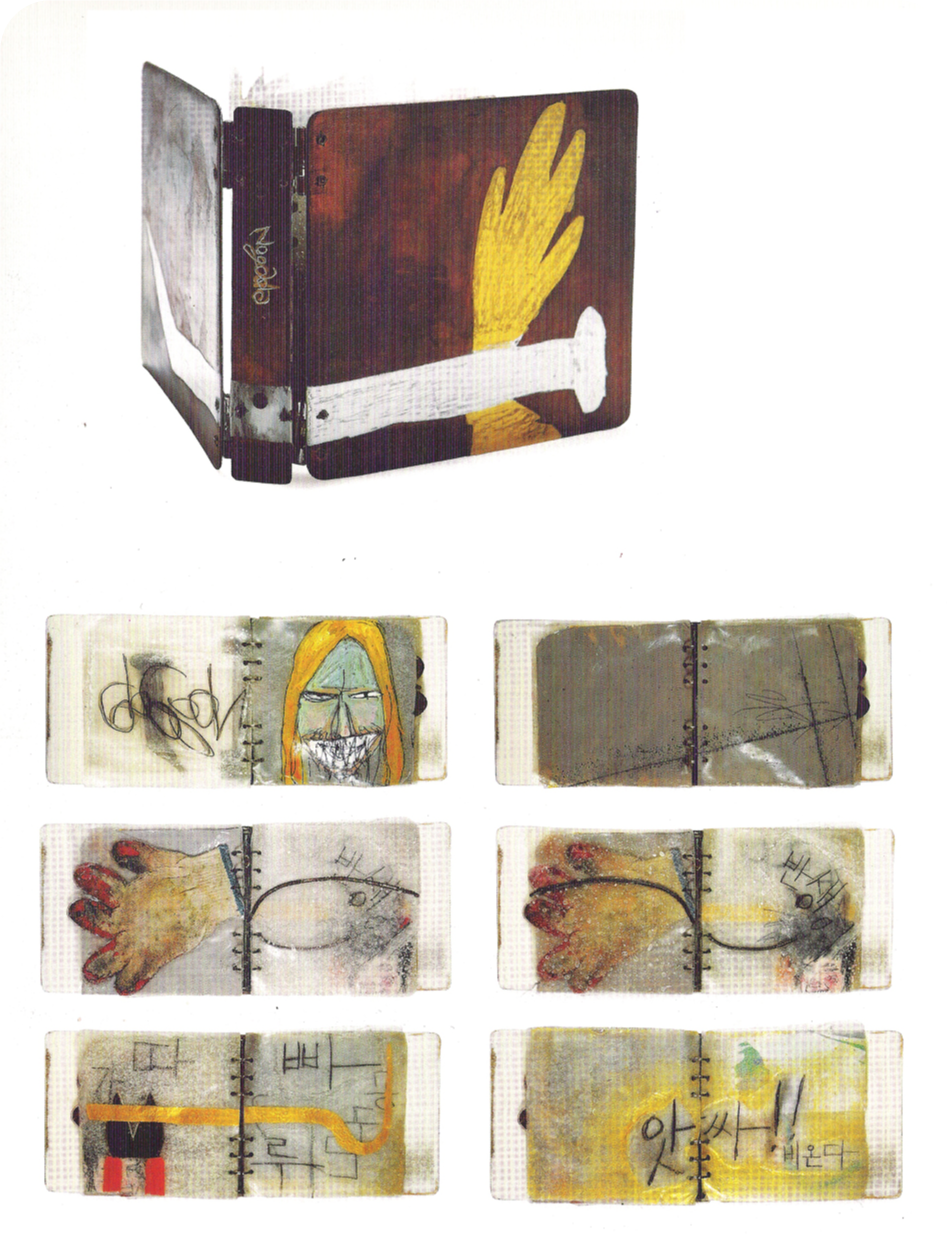
Artbook NOGADA
mix media
19x21x4cm
34page
2006

노가다 NOGADA
wood, polystyrene, acrylic, gloves
12x5.7x4cm
2006

여름 Summer
acrylic on wood board
64x27cm
2006

안전제일 Safety is best
acrylic on the form(for a casting architecture)
120x180cm
2006

NOGADA
pen on paper
46x22cm
2008
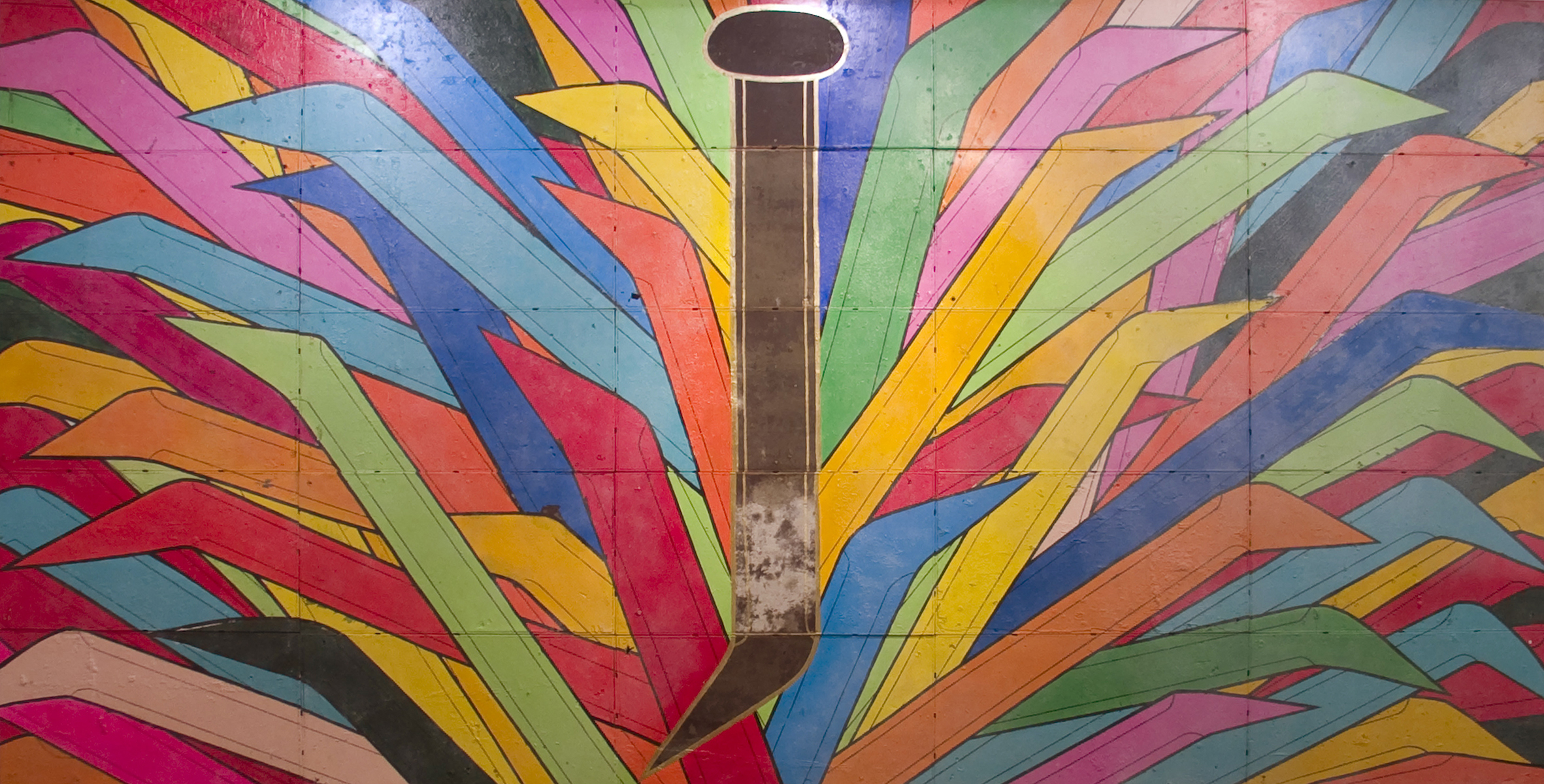
Toy SINO
acrylic on the form(for a casting architecture)
300x600cm
2007

Toy Nogada_Capsule SINO
Toy Machine
25x25x85cm
2007
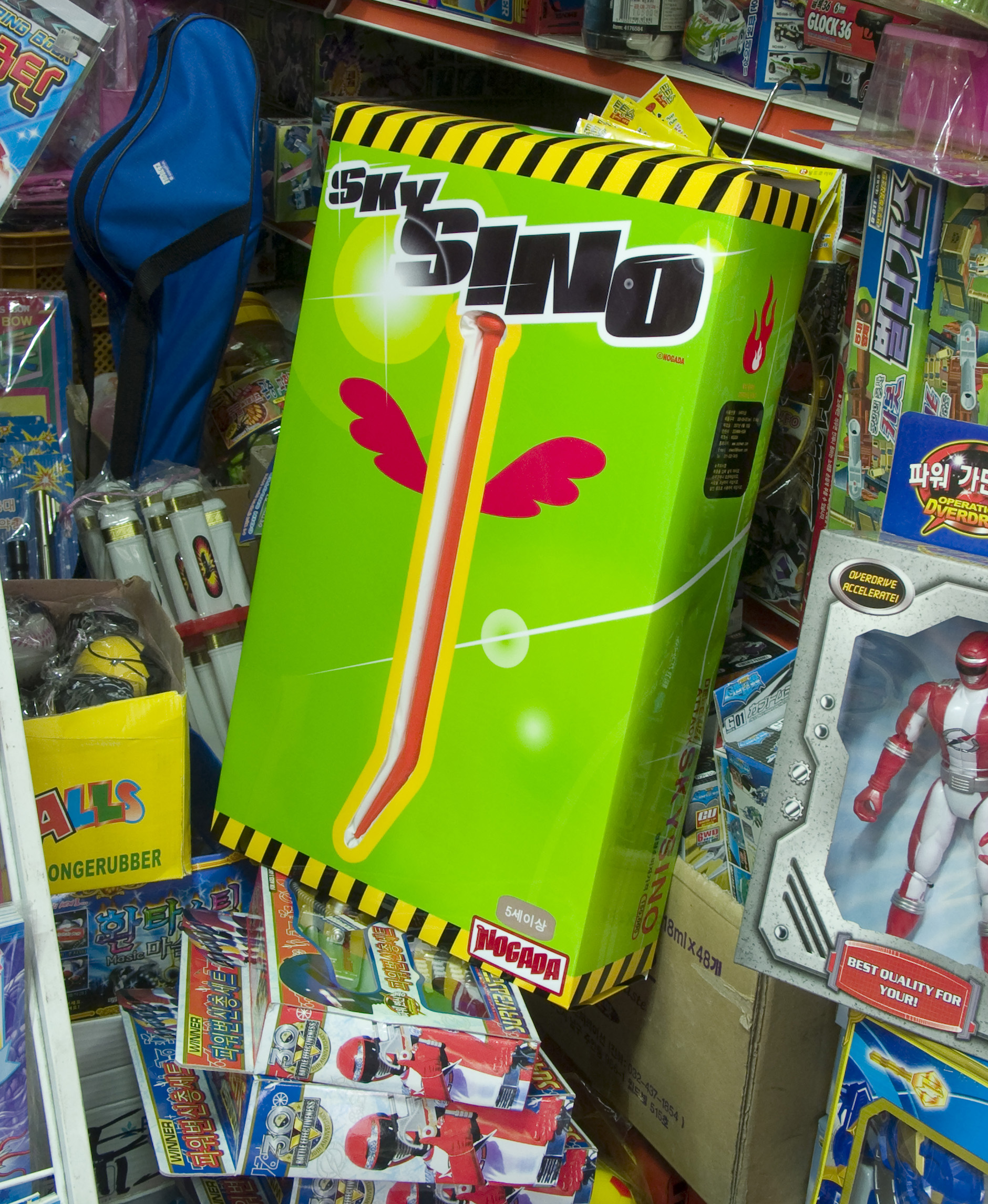
Toy Nogada_SKY SINO
acrylic on SINO, digital print
30x10x50cm
2007


SINO House
SINO, galvanized steel sheet, wood
350x320x315cm
2007
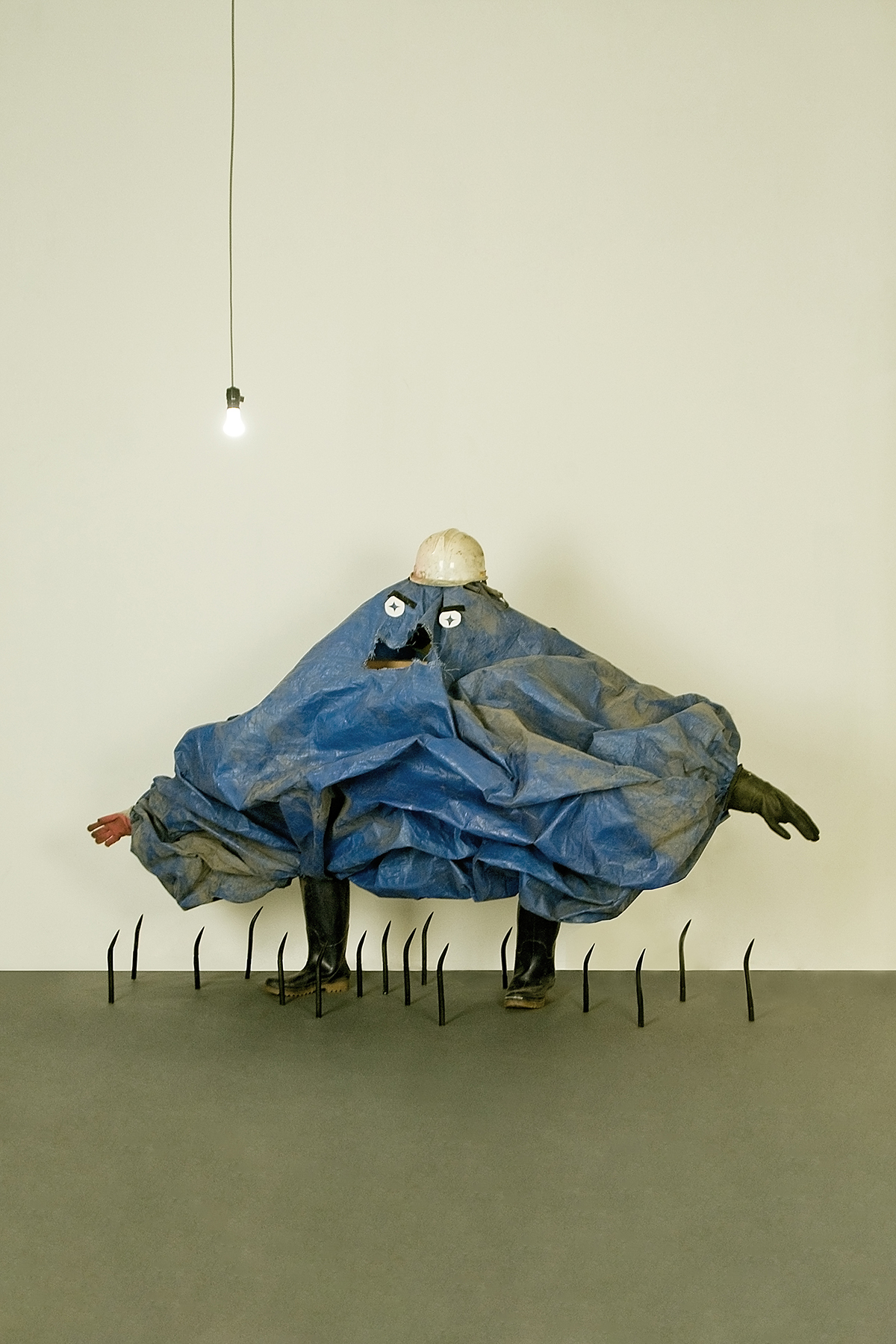
NOGADA Man
useless materials
220x135cm
2009

SINO
useless wood
30x30x156cm
2008


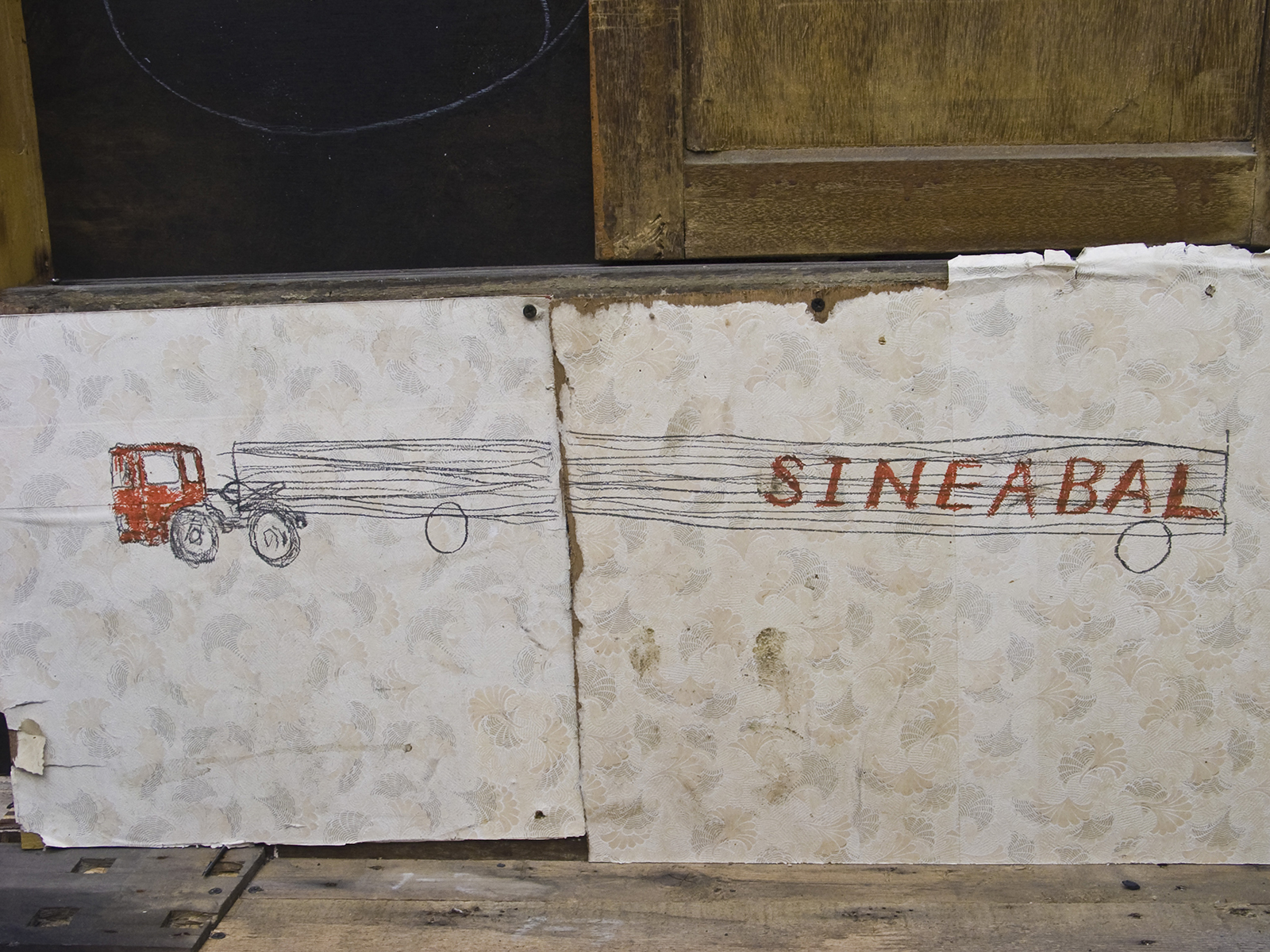
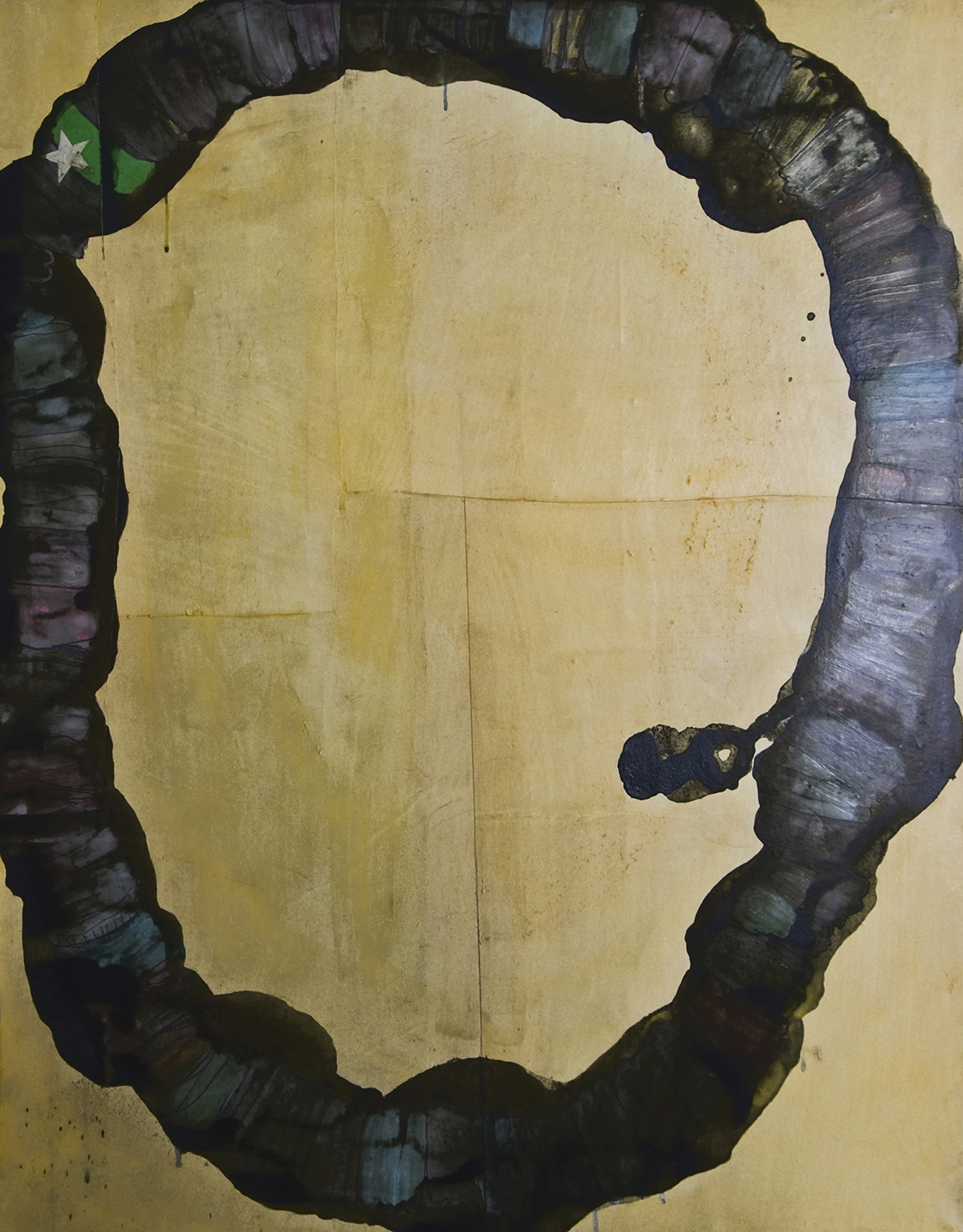

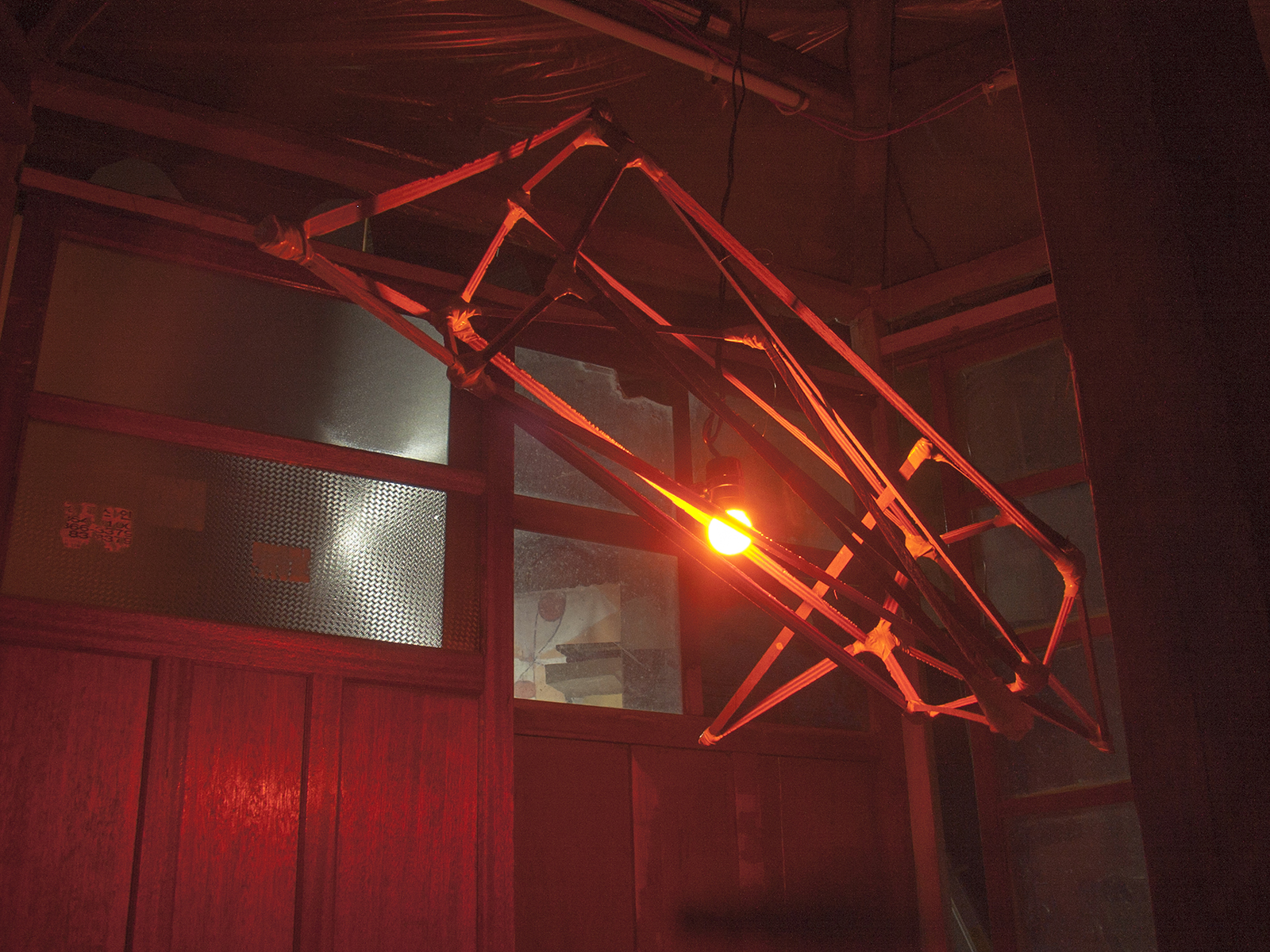
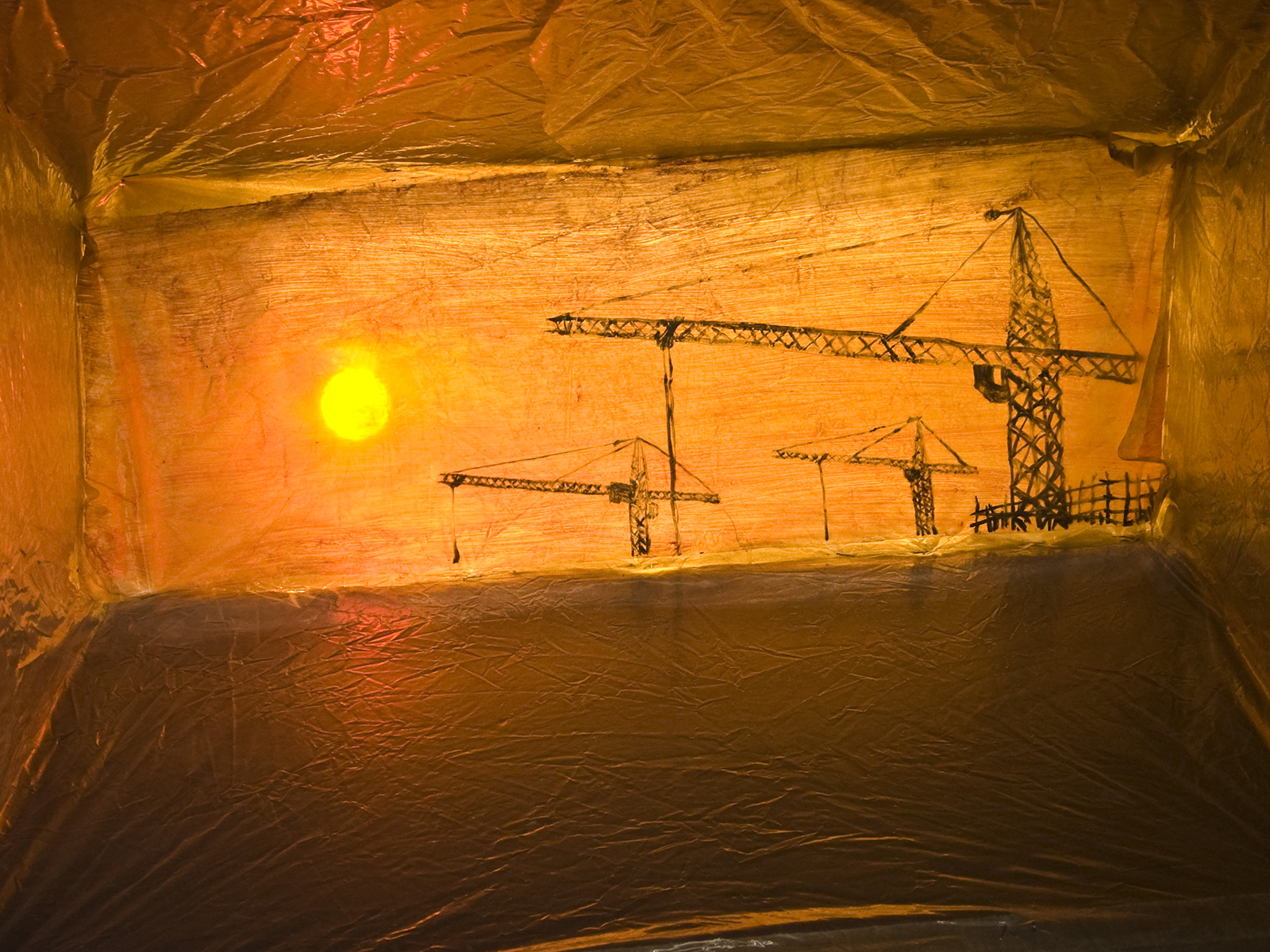
노가다주식회사Nogada, INC.
useless materials, bulb, briquette, acrylic
370x370x300cm
2008

노가다란 무엇인가?! What id the NOGADA?!
ink, pencil, acrylic on paper
183x160cm
2009
노가다를 고찰하다
-김지혜(미학)
어느덧 가을이 되었고, 서쪽에서 바람이 불어오기 시작했다. 이 여리고 예민한 바람이 흔들지 못할 만큼 농익은 햇살이 어느덧 짜릿하게 내려와 그 남자의 얼굴에 선명한 그림자를 만들었다. 주변을 둘러보니 저마다의 얼굴에 볕이 내려와 있었고, 그림자가 생겨나 있었다. 잠시 동안 고요 안에 머무르며 그 남자는 이 세상 모든 이에게 심지어는 낡고 바랜 자신의 구두 위에 똑같은 양만큼 내리쬐는 태양에 감사했으며, 그 아래서 노동할 수 있다는 데 벅차오르는 감정을 느꼈다. 노동은 그 동안 구축되어온 인간사에서 그 무엇보다 중요한 역할을 해왔으며, 그로 인해 문명은 발달하였다는 게 그의 생각이었다. 그리고 그는 하늘에서 똑같은 양만큼 내리쬐는 태양만큼 똑같이 주어진 신성한 노동 역시 고마움의 대상이라 여겼다. 그의 이러한 감상은 매우 긍정적이며, 낙천적인 것이지만, 역시 그 안에는 지나치게 낭만적인 구석이 있기도 하다.
레프 니코라예비치 톨스토이는『부활』에서 헨리 조지의 '지대공유론'을 인용하며 "땅은 모두의 것입니다. 모든 사람은 꼭 같이 땅을 가질 권리를 가지고 있습니다."라고 말한 바 있다. 그리고 땅 위에 살면서 땅에서 나는 소산으로 먹고 살 수 있다는 가능성은 언제나 가장 행복하고 독립된 개인의 삶에서 주요한 조건 중 하나라고 말하기도 하였다. 하지만 톨스토이의 의견에도 역시 다소 낭만적인 면이 있다. 실제로 노동은 모든 이에게 같은 양만큼 주어지지 않았으며, 노동을 하는 자와 그들이 생산한 상품을 향유하는 자는 분명히 구분되어왔기 때문이다. 고로 막심 고리끼는 결국 그의 사유와 결별했는지도 모르겠다. 육체로 노동의 다양한 영역을 골고루 경험한 그에게 톨스토이의 노동론과 아나키즘은 현실 저 편에 있는 것으로 여겨질 수밖에 없었을 테니 말이다.
여기서 우리는 다음과 같이 질문할 수 있다. 노동에 대해 말할 때 진정성을 갖추기 위해서는 노동의 경험이 선재해야 하는가? 진정성은 절절한 체험과 적극적인 참여를 통해서만 가능한가? 대답은 아마도 "우선 그렇다"가 될 것이다. 더욱이 "노동은 다른 동물과 구별하도록 하는 인간의 본질적 속성으로서, 즉 인간 자신을 유적 존재로 실현하고 증명하도록 해주는 것"이라는 마르크스의 말처럼, 노동은 생각보다 신성하고, 존귀한 것이기 때문이다. 하지만 위의 질문들에 대한 또 다른 대답이 있을 수도 있는데, 그것은 "그렇지 않을 가능성도 있다"는 것이다. 노동의 영역이 어디에서부터 어디까지인가라는 새로운 질문이 발생할 수 있기 때문이다. 또한 '진정성'이라는 것은 깊은 반성과 성찰 그리고 타자에 대한 진심어린 관심과 타인의 삶에 대한 심적 개입이 있어야 가능한 것이기 때문이다.
이러한 이야기들은 작가 김수환의 작업을 말하기 위한 것들이다. 그의 가족사는 대한민국의 격변적인 현대사와 함께하였으며, 또한 섬세한 노동의 변천사에 걸쳐져 있다. 더욱이 그의 조모와 아버지, 삼촌 그리고 동생까지 몸담고 있는 노동의 터전은 우리 근현대사에서 가장 확실한 변화의 지점을 찍어온 인천이다. 고로 그에게 '노가다'는 가족처럼 친근한 것이며, 고마운 것이며, 또한 어느 지점에서는 불편한 것이며, 어려운 것이기도 하다.
김수환은 여러 작업의 방식을 통해 ‘노가다’의 다양한 면모를 보여주었다. 인천 재개발 지역 한복판에 집-이 집은 후에 강제 철거되었다-을 짓기도 하였고, 직접 내부를 꾸며 전시공간을 만들기도 하였다. 또 공사장에서 노동을 하며 친숙해진 도구, SINO에 호흡을 불어넣어 식물처럼 키워내기도 하였으며, 장난감으로 만들어 관객들에게 제공하기도 하였다. 그의 작업에서 두드러진 특징이 있다면, 이 모든 맥락이 우울과 어두움으로 점철되어 있지 않다는 것과 작품 속에 그 만의 특유한 유머와 위트를 불어넣고 있다는 점이다.
이 점에 대해 되뇌어 보면, 우리는 ‘노동’이 현실이 되고, ‘실제’가 될 때, 모든 노동자가 노동의 향유자에 대한 반감과 적개심으로 ‘노동’을 하지 않으며, 그것은 긴 시간 동안 미시적 삶들의 원천이 되고, 더욱이 때로는 고맙고 감사한 것이 될 수 있으며, 때로는 즐거움을 주는 것일 수도 있다는 사실을 알 수 있다. 또 마찬가지로 그것이 삶이 될 때, 얻게 되는 고달픔과 버거움은 더욱 깊이 있게 드러나기도 한다는 것을 깨닫게 되기도 한다. 하지만 이때 도출되는 표현들은 지나치게 낭만적이거나 과격하지 않다. 마치 박영근의 담백하면서 위트 있는 시처럼 말이다. 누군가 지적한 바대로, 경험하지 않은 자들의 표현은 지나치게 강렬하거나 지나치게 냉철할 가능성이 높다. 그것은 때로 지나치게 낭만적이거나 감상적으로 흘러가기도 하고, 분석적이거나 과학적으로 흘러가기도 한다. 하지만 김수환이 획득하고 있는 것은 그것 안에 깊숙이 관여하고 있되 그 현상으로부터 거리를 두어 담백하게 이야기하고 있다는 것이다.
그의 작업 중에서 특히 드로잉과 텍스트들은 강한 인상을 남긴다. 그의 손끝에서 다양한 장면들은 담백하게 피어나고, 성장하여 화려하지는 않지만 생명력 있는 식물군을 이루고 있는 것만 같다. 그의 드로잉은 일견 톨스토이보다는 고리끼와 닿아있다. 확실히 체험과 경험 그리고 지극히 미시적인 가족사로부터 작업이 출발하고 있기 때문이다. 이는 마치 랑시에르가 알튀세르를 비판한 것과 맥락이 유사하지만, 고리끼와 김수환 사이에 차이가 있다면, 고리끼의 처절한 절망감이나 적개심의 무게가 덜어졌다는 사실일 것이다.
또한 솔직하고 담백하게 써내려간 다양한 글들도 ‘진정성’을 담보로 신선한 감동을 준다. (실제로 작가는 상당한 문학적 감수성을 지니고 있는 듯하다.) 모두가 뇌세포를 자극할 정도로 강렬한 자극과 심장을 울릴 만큼 센 감동을 주고자 하고, 그러한 것들이 예술의 덕목이라도 되는 것 마냥 여기는 시대에, 여리지만 진정성 있는 자극으로 우리의 마음에 와 닿는 김수환의 작업들은 긴 여운을 남긴다. 그것은 마치 어느 가을 날 내려와 나와 당신의 얼굴에 같은 그림자를 만드는 농익은 햇살이 주는 짙은 감동과도 같다.
-
김지혜(KIM Jihye)는 홍익대학교 미학과 석사과정을 졸업하고, 숙명여자대학교 미술사학과 를 수료하였으며, 홍익대학교 미학과 박사과정에 재학중이다. 대안공간 루프, KT아트홀, KTF갤러리 등에서 큐레이터로 일했으며, 독립큐레이터로《두리안 세 번째 파이공장》(서교예술실험센터, 서울, 한국), 《두리안 파이공장》(호치민미술대학, 호치민, 베트남), 《후인마이의 편지》(KT&G 상상마당, 서울, 한국), 《이모를 찾아라》(서교예술실험센터, 서울, 한국), 《공가공갈단》(문화일보갤러리, 서울, 한국) 등을 기획하였으며, 다양한 매체에 대중과 아동을 위한 글쓰기 작업을 하고 있다.
Consideration on ‘Nogada’(construction workers)
-KIM Ji-hye(Aesthetics)
Now that fall is here, and the wind has begun to blow from the west. The brilliant sun which this soft and keen wind couldn't shake was beating down, throwing hard-edged shadows on the man's face. As he looked around, the sun was beating down on everyone's faces, and shadows appeared. Staying within the stillness for a while, the man was thankful to everyone in the world, and to the sun for equally beating down on even his old, faded shoes, and then he felt overflowing emotions for being able to labor under the sun. He thought labor had played a more important role than anything else in human history and civilization had developed due to labor. And he regarded a sacred labor, which was equally given, as an object of gratitude, like the sun which beat down equally from heaven. His thoughts were very positive and optimistic but also excessively romantic.
Citing Henry George's 'theory of Land Sharing', Lev Nikolajevic Tolstoj said, in the novel 『Resurrection』, "Land belongs to all people. All of them have the right to have it equally." He also said that the possibility that you could live on the land and live on the fruits produced on the land was always one of the major conditions in the most happy and independent life of an individual. But Tolstoj's opinion is also somewhat romantic. That's because labor, in fact, isn't equally given to everyone, and people to labor and people to enjoy the products produced by laborers have been clearly separated. For that reason, Maxime Gorikki might eventually declare his intent to separate from Tolstoj. That's because Gorikki, who evenly experienced various areas of labor in flesh and blood, could not help considering Tolstoj's labor theory and anarchism as the things that were at the other side of reality.
We can, here, ask questions as follows. Should the experience of labor preexist in order to achieve authenticity when speaking of labor? Can authenticity be achieved only through intense experiences and active participation? The answers will probably be "Yes, first". That's because, like Marx's words, "Labor is a human intrinsic property to distinguish human beings from other animals, in other words, labor makes human beings realize and prove themselves as their presence", labor is sacred and honorable than you might think. However, you can differently answer to the above, that is, "There is a possibility that it seems not". That's because you can bring up a new question that the area of labor is from where to where. That's also because 'authenticity' is possible when it is equipped with a deep reflection and introspection, a sincere interest in others and a mental intervention in the lives of others.
These stories are for speaking of the work of KIM Soo-hwan, artist. His family history has sunk or swum together with the sudden changes in Korean modern history, and it has been related with the whole changes that has taken place in labor. Moreover, a base for labor which his grandmother, father, uncle and brother have been in is the city of Incheon which has marked with the most obvious point of change in our modern and contemporary history. Therefore, the 'Nogada', construction workers, is, for him, familiar and grateful like family as well as uncomfortable and inaccessible at some point.
KIM Soo-hwan has showed various aspects of 'Nogada' through the several methods of work. KIM built a house in the middle of Incheon redevelopment area-the house was demolished by force afterward- and also did an exhibition space by directly decorating the interior. Also, KIM infused life into SINO, a tool which became familiar with him during laboring on construction sites, raising it like a plant, and made toys from it, offering them to spectators. The distinctive features of his work are that the context of all this is not marked by melancholy and darkness and that he infuses his own peculiar humor and wit into the works.
When we think again about this point, we will know the fact that, when 'labor' becomes a reality and 'real', all the laborers won't 'labor' with the hostility and antipathy against the people to enjoy the labor of others, and that labor will become the source of microscopic lives for a long time, and be sometimes grateful and thankful to us, and be sometimes able to give us pleasure. And also, we will realize the weariness and tiredness gained when labor becomes life will emerge more deeply. However, the expressions derived from this are not overly romantic or radical, just like PARK Young-geun‘s light and witty poetry. As someone pointed it out, it is likely to be excessively intense or realistic that those who have not experienced it express their opinions of it. Their opinions are sometimes biased; overly romantic and sentimental, or analytical and scientific. But what KIM Sou-hwan has acquired is that KIM talks of the phenomenon with candor, by being deeply involved in it but keeping his distance from it.
Especially the drawings and the texts, of his work, leave a strong impression. It seems that various scenes are created with candor from his fingertips, grow up, and form a flora which isn't splendid but has vitality. His drawings are, at a glance, more connected with Gorikki than Tolstoj. That's because his work certainly starts from his own experiences and his very microscopic family history. This can be understood in the same context as Rancière criticized Althusser, but the difference between Gorikki and Kim Sou-hwan would be that Gorikki's weight of despair or hostility has been relieved.
In addition, the various texts written by KIM very openly and with candor give us a fresh impression with 'authenticity'. (In fact, the artist seems to have a considerable literary sensibility.) In these times when all people try to give a stimulation that is strong enough to stimulate brain cells and an impression that is intense enough to pound hearts, and when they consider all these things as the virtues of arts, KIM Sou-hwan's work which touches our hearts with a weak but authentic stimulation leaves a good taste for a long time. It's like a brilliant sunlight, which comes down an autumn day and creates same shadows on my and your faces, makes a deep impression.
-
KIM Ji-hye: Graduated from the master's course at the Dept. of Aesthetics, Hongik University, and finished the Dept. of Art History, Sookmyung Women's University, and now is in the doctor's course at the Dept. of Aesthetics, Hongik University. Worked as a curator at Alternative Space Loop, KT Art Hall, KTF Gallery, etc, and planned, as an independent curator, the exhibitions including《Durian Third Pie Factory》(Seogyo Arts Experiment Center, Seoul, Korea), 《Durian Pie Factory》(Ho Chi Minh City Fine Arts University, Ho Chi Minh, Vietnam), 《Huynh Mai's Letter》(KT&G Sangsangmadang, Seoul, Korea), 《Look for an Aunt》(Seogyo Arts Experiment Center, Seoul, Korea), and《Gongga Gong Galdan》(Munwha Ilbo Gallery, Seoul, Korea). She has written for the public and children in a variety of media.